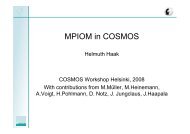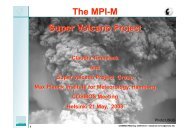Icon, Combine - COSMOS
Icon, Combine - COSMOS
Icon, Combine - COSMOS
Create successful ePaper yourself
Turn your PDF publications into a flip-book with our unique Google optimized e-Paper software.
The <strong>COSMOS</strong> framework<br />
ICON<br />
COMBINE<br />
<strong>COSMOS</strong> annual meeting, Helsinki, 2008<br />
Marco Giorgetta
.<br />
Content<br />
� ...<br />
� Motivation<br />
� Status<br />
� Developments<br />
� Model names
.<br />
Motivation<br />
Which are driving forces in model development?<br />
� New scientific questions (Projects)<br />
� Different scales in time and/or space<br />
� New process models<br />
� New numerical techniques<br />
� New experimental designs<br />
� New environment where to use models<br />
� Portability<br />
� Optimization<br />
� New software techniques<br />
� Data structures<br />
� Parallelization<br />
� Domain decomposition
.<br />
Status<br />
<strong>COSMOS</strong> “Millennium”<br />
� SCE+SRE:<br />
� Models:<br />
� “cosmos-a” � ECHAM5 =<br />
atmosphere<br />
� “cosmos-o” � MPIOM = ocean<br />
� “cosmos-ob” � MPIOM-HAMOCC= ocean + biogeochemistry<br />
� “cosmos-ao” � ECHAM5/MPIOM = atmosphere ocean<br />
� “cosmos-asob” � ECHAM5-JSBACH/MPIOM-HAMOCC<br />
= carbon cycle<br />
� Resolutions:<br />
� T31L19/GR3L40<br />
� T63L31/GR1.5L40 (tests, spin-up)<br />
� Computers/Sites<br />
� DKRZ, FMI, …<br />
� Codes:<br />
� ECHAM5.4.01, ECHAM5-HAM, ECHAM5J<br />
� MPIOM<br />
� HAMOCC<br />
� OASIS3
.<br />
Developments<br />
Ongoing<br />
� Higher resolution version (T63 L31 / GR1.5 L40) of the Millennium<br />
model<br />
� Inclusion of HAM in standard ECHAM5 code<br />
� Implementation of CDNC cloud scheme of U. Lohmann for aerosol<br />
clouds interaction<br />
� Chemistry aerosol cloud coupling (“HAMMOZ”)<br />
� SALSA aerosol scheme<br />
� Dynamical vegetation and land use<br />
� Tri-polar higher resolution ocean grid TP0.4, TP0.1
.<br />
Developments<br />
Further developments<br />
� Radiation: Test new radiation package of ECMWF including<br />
RRTM-LW, RRTM-SW and McICA cloud generator?<br />
� Fast chemisty (family concept)<br />
� Methane processes (wetlands, permafrost)<br />
� Nitrogen cycle<br />
� Isotopes<br />
� Compiling system (Autoconf)<br />
� Running environment<br />
� Coupler: OASIS3 � OASIS4
.<br />
Priorities<br />
� Technical Documentation<br />
� High resolution carbon cycle model � Millennium<br />
� Aerosols � Volcanoe<br />
� Fast chemistry for century time scale experiments<br />
� Detailed chemistry for shorter time scales / campaigns<br />
� Optimization for use on new DKRZ computers
.<br />
Other presentations related to specific models:<br />
� Johann Jungclaus Millennium<br />
� Harri Kokkola Salsa<br />
� Martin Schulz ECHAM5-HAMMOZ<br />
� Malte Müller MPIOM<br />
� Christian Reick JSBACH<br />
� Joachim Segschneider HAMOCC
.<br />
Model names (1/2)<br />
� As more configurations become possible, names become longer<br />
and more complicated<br />
� Names are used in the configuration process to construct model<br />
and scripts<br />
� Current names: “<strong>COSMOS</strong>-XYZ”<br />
“XYZ” shows components<br />
� A: Atmosphere dynamics+physics � ECHAM5<br />
� S: Surface, soil and vegetation � JSBACH<br />
� O: Ocean dynamics and physics � MPIOM<br />
� B: Ocean Biogeochem. + sediments � HAMOCC<br />
� Example: <strong>COSMOS</strong>-ASOB is the carbon cycle model configuration<br />
used for the Millennium project
.<br />
Model names (2/2)<br />
� The model complexity is growing further<br />
� Aerosols HAM, SALSA, SAM2<br />
� Chemistry MOZART (, MECCA, (CHEM2))<br />
� Add more letters for model configuration?<br />
� M for aerosol microphysics<br />
� C for chemistry<br />
� <strong>COSMOS</strong>-[A, C, M; S; O, B]<br />
� Problem: single letters not sufficient to describe specific model<br />
setups, e.g. Because of different aerosol and chemistry schemes<br />
� Alternative: Use project names to tag and name model<br />
configurations for specific projects<br />
Examples: “IPCC model”, “Millennium model”
ICON<br />
Icosahedral Non-hydrostatic General Circulation Models<br />
A joint MPI-M DWD project<br />
ICON will provide future dynamical cores and<br />
atmosphere and ocean GCMs for <strong>COSMOS</strong>
MPI-M & DWD collaboration<br />
� Benefits of MPI-M from DWD<br />
� operational mode (daily testing & verification),<br />
� comparing against observations: atmospheric data assimilation<br />
� Benefits of DWD from MPI-M<br />
� seasonal prediction (including ocean model)<br />
� experience with stratosphere<br />
� Joint pool of physics packages
Model characteristics<br />
� Joint grid – joint numerics (at least operators, solvers)<br />
� Structure-preserving-discretization<br />
� conserve relevant quantities on discrete level<br />
(energy, Ertel’s potential vorticity, total mass, tracer mass)<br />
� Zooming ability<br />
� Modern software architecture<br />
� object-orientated programming<br />
� Keep the model “open”<br />
� Encourage/facilitate model adaption & extension by users<br />
� High scalability for next generation computers
.<br />
Grid generator<br />
Concept of patches<br />
� for refinement<br />
� for domain decomposition<br />
Unstructured grid<br />
� minimize distance between neighbors<br />
in memory<br />
� only relationships between neighbors<br />
are stored: no traditional array data<br />
structure
Basic operators on the C-grid: div-grad-curl<br />
Rotation for hexagons:<br />
Stokes theorem<br />
The velocity is given counterclockwise.<br />
Application of integral theorems<br />
Divergence for triangles:<br />
Gauss theorem<br />
The velocity points outward.<br />
Gradient at an edge:<br />
given by the relation
ICON Models, work in progress<br />
Grid generator<br />
– Global or regional triangular grids derived from icosahedron<br />
– Optimization to improve accuracy of numerical operators<br />
Discretization and operators<br />
- C-grid discretization<br />
- Div, Grad, …<br />
Infrastructure<br />
- Data structure allowing regional refinements, domain composed of patches<br />
- Parallelization (MPI & OpenMP)<br />
- Asynchronous and parallel I/O<br />
- Encoding (NetCDF, GRIB)<br />
- Postprocessing (CDO)<br />
Dynamical cores<br />
- Shallow water model (ICOSWM)<br />
- Vertical slice model<br />
- Hydrostatic atmosphere<br />
- Hydrostatic ocean<br />
- Non-hydrostatic atmosphere<br />
Earth system model / <strong>COSMOS</strong><br />
- OASIS<br />
- ICOxAM<br />
- ICOHOM<br />
General circulation models<br />
- Hydrostatic atmosphere (ICOHAM)<br />
- Hydrostatic ocean (ICOHOM)<br />
- Non-hydrostatic atmosphere (ICONAM)
COMBINE:<br />
Comprehensive Modelling of the<br />
Earth System for Better Climate<br />
Prediction and Projection<br />
Call: FP7, 2nd call (29 Nov.-25 Feb.)<br />
Topic: New components in Earth System modelling for better climate<br />
projections<br />
Funding scheme: Large-scale integrating project, 4-8 M€
.<br />
COMBINE Abstract<br />
� The European integrating project COMBINE brings together research groups to<br />
advance Earth system models (ESMs) for more accurate climate projections and for<br />
reduced uncertainty in the prediction of climate and climate change in the next<br />
decades. COMBINE will contribute to better assessments of changes in the physical<br />
climate system and of their impacts in the societal and economic system. The<br />
proposed work will strengthen the scientific base for environmental policies of the<br />
EU for the post-2012 climate negotiations.<br />
� COMBINE proposes to improve ESMs by including key physical and<br />
biogeochemical processes to model more accurately the forcing mechanisms and<br />
the feedbacks determining the magnitude of climate change in the 21st century. For<br />
this purpose the project will incorporate carbon and nitrogen cycle, aerosols<br />
coupled to cloud microphysics and chemistry, proper stratospheric dynamics and<br />
increased resolution, ice sheets and permafrost in current Earth system models.<br />
COMBINE also proposes to improve initialisation techniques to make the best<br />
possible use of observation based analyses of ocean and ice to benefit from the<br />
predictability of the climate system in predictions of the climate of the next few<br />
decades. Combining more realistic models and skilful initialisation is expected to<br />
reduce the uncertainty in climate projections.<br />
� Resulting effects will be investigated in the physical climate system and in impacts<br />
on water availability and agriculture, globally and in 3 regions under the influence of<br />
different climate feedback mechanisms. Results from the comprehensive ESMs will<br />
be used in an integrated assessment model to test the underlying assumptions in<br />
the scenarios, and hence to contribute to improved scenarios. COMBINE will make<br />
use of the experimental design and of the scenarios proposed for IPCC AR5.<br />
Therefore the project will be able to contribute to the AR5, by its relevant research<br />
and by the contribution of experiments to the IPCC data archives.
.<br />
COMBINE – Abstract (1)<br />
� COMBINE proposes to improve ESMs by including<br />
key physical and biogeochemical processes to<br />
model more accurately the forcing mechanisms and<br />
the feedbacks determining the magnitude of climate<br />
change in the 21st century. For this purpose the project<br />
will incorporate carbon and nitrogen cycle, aerosols<br />
coupled to cloud microphysics and chemistry,<br />
proper stratospheric dynamics and increased<br />
resolution, ice sheets and permafrost in current<br />
Earth system models.
.<br />
COMBINE – Abstract (2)<br />
� COMBINE also proposes to improve initialisation<br />
techniques to make the best possible use of<br />
observation based analyses of ocean and ice to benefit<br />
from the predictability of the climate system in<br />
predictions of the climate of the next few decades.<br />
� Combining more realistic models and skilful initialisation<br />
is expected to reduce the uncertainty in climate<br />
projections.
.<br />
COMBINE – Abstract (3)<br />
� Resulting effects will be investigated in the physical<br />
climate system and in impacts on water availability<br />
and agriculture, globally and in 3 regions under the<br />
influence of different climate feedback mechanisms.<br />
Results from the comprehensive ESMs will be used<br />
in an integrated assessment model to test the<br />
underlying assumptions in the scenarios, and hence<br />
to contribute to improved scenarios. COMBINE will<br />
make use of the experimental design and of the<br />
scenarios proposed for IPCC AR5. Therefore the<br />
project will be able to contribute to the AR5, by its<br />
relevant research and by the contribution of<br />
experiments to the IPCC data archives
.<br />
New components Experimental design<br />
New components<br />
(C1) Carbon an nitrogen cycle<br />
(C2) Aerosols, clouds and chemistry<br />
(C3) Stratosphere<br />
(C4) Cryosphere<br />
(C5) Initialisation<br />
ESM combinations Differences<br />
(E1) ESM D Α (C(i)) = (E2) – (E1)<br />
(E2) ESM + C(i) D Ω (C(i)) = (E4) – (E3)<br />
(E3) newESM – C(i) D Σ (Σ j C(j)) = (E4) – (E1)<br />
(E4) newESM<br />
CMIP simulations, centennial and decadal<br />
Centennial Simulation Decadal Simulation<br />
(CS1) Pre-industrial control (DS1) Climate prediction (2005-2035)<br />
(CS2) 20 th century (DS2) Climate hindcasts<br />
(CS3) 21 st century scenario<br />
(Representative Concentration Pathway scen.)<br />
(CS4) +1% CO 2 / year to 4xCO 2
.<br />
ESMs and main developers<br />
ESMs Main developer<br />
(M1) <strong>COSMOS</strong> MPG<br />
(M2) HadCM,<br />
HadGEM<br />
METO<br />
(M3) IPSL-ESM CNRS<br />
(M4) CMCC CMCC<br />
(M5) CNRM-CM MF-CNRM<br />
(M6) EC-EARTH ECMWF, EC-Earth consortium<br />
(M7) NORCLIM UiB<br />
Work packages<br />
New components CMIP/AR5 + Evaluation<br />
(WP1) C and N cycle (WP6) Decadal climate<br />
prediction<br />
(WP2) Aerosols, clouds and chemistry (WP7) Climate projections<br />
and feedbacks<br />
(WP3) Stratosphere (WP8) Impacts and Scenarios<br />
(WP4) Cryosphere<br />
(WP5) Initialisation
.<br />
COMINE Pert diagram<br />
.
.<br />
Partners 1-11 of 23<br />
Number* Short<br />
name<br />
1<br />
(Coord.)<br />
Organisation name Cou<br />
ntry<br />
MPG Max-Planck-Gesellschaft<br />
(MPI-M + MPI-BGC)<br />
2 METO Met Office UK<br />
3 CNRS Centre National de la Recherche<br />
Scientifique<br />
4 CMCC Centro Euro-Mediterraneo per i<br />
Cambiamenti Climatici<br />
5 MF-CNRM Météo-France - Centre National de<br />
Recherches Météorologiques<br />
6 KNMI Het Koninklijk Nederlands<br />
Meteorologisch Instituut<br />
7 UiB University of Bergen NO<br />
8 DMI Danish Meteorological Institute DK<br />
9 ECMWF European Centre for Medium-Range<br />
Weather Forecast<br />
10 ETHZ Eidgenössische Technische<br />
Hochschule Zürich<br />
11 FMI Finnish Meteorological Institute FI<br />
DE<br />
FR<br />
IT<br />
FR<br />
NL<br />
UK<br />
CH
.<br />
Partners 12-23 of 23<br />
Number* Short<br />
name<br />
Organisation name Cou<br />
ntry<br />
12 MNP Netherlands Environmental Assessment<br />
Agency<br />
13 SMHI Swedish Meteorological and<br />
Hydrological Institute<br />
14 WU Wageningen University & Research<br />
Centre<br />
15 UHEL University of Helsinki FI<br />
16 CERFACS European Centre for Research and<br />
Advanced Training in Scientific<br />
Computation<br />
17 UCL Université Catholique de Louvain BE<br />
18 UNIVBRIS University of Bristol UK<br />
19 Uni Kassel University of Kassel - Center for<br />
Environmental Systems Research<br />
(CESR)<br />
20 TUC Technical University of Crete GR<br />
21 CYI Cyprus Research and Educational<br />
Foundation<br />
22 INPE Instituto Nacional de Pesquisas<br />
Espaciais<br />
NL<br />
SE<br />
NL<br />
FR<br />
DE<br />
CY<br />
BR
. � Status:<br />
� Evaluation done<br />
� So far no offical message, but some rumours<br />
� Invitation for negotiation in September or October<br />
� Perspective:<br />
� Chance for interesting research<br />
� Progress in the development of the <strong>COSMOS</strong> ESM
.<br />
END




